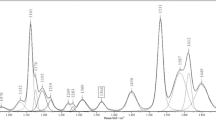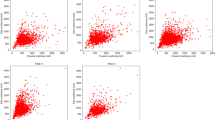Abstract
The discrimination and classification of allergy-relevant pollen was studied for the first time by mid-infrared Fourier transform infrared (FT-IR) microspectroscopy together with unsupervised and supervised multivariate statistical methods. Pollen samples of 11 different taxa were collected, whose outdoor air concentration during the flowering time is typically measured by aerobiological monitoring networks. Unsupervised hierarchical cluster analysis provided valuable information about the reproducibility of FT-IR spectra of the same taxon acquired either from one pollen grain in a 25 × 25 μm2 area or from a group of grains inside a 100 × 100 μm2 area. As regards the supervised learning method, best results were achieved using a K nearest neighbors classifier and the leave-one-out cross-validation procedure on the dataset composed of single pollen grain spectra (overall accuracy 84%). FT-IR microspectroscopy is therefore a reliable method for discrimination and classification of allergenic pollen. The limits of its practical application to the monitoring performed in the aerobiological stations were also discussed.

Traditional and innovative methods for the identification of airborne pollen grains





Similar content being viewed by others
References
Johansson SGO (2002) Clin Exp Allergy 2:2–7
Weber RW (1998) Ann Allergy 80:141–145
Chuine I, Belmonte J (2004) Grana 43:65–80
Faegri K, Iersen J (1989) Textbook of pollen analysis. John Wiley & Sons Ltd, London UK
Moore PD, Webb JA, Collinson ME (1991) Pollen analysis. Blackwell Scientific Publications, Oxford UK
Hirst JM (1952) Ann Appl Biol 39:257–265
Naumann D, Helm D, Labischinski H (1991) Nature 351:81–82
Nabet A, Pezolet M (1997) Appl Spectros 51:466–469
Petibois C, Gionnet K, Goncalves M, Perromat A, Moenner M, Deleris G (2006) Analyst 131:640–647
Orsini F, Ami D, Villa AM, Sala G, Bellotti MG, Doglia SM (2000) J Microbiol Meth 42:17–27
Mariey L, Signolle JP, Amiel C, Travert J (2001) Vib Spectros 26:151–159
Miguel Gomez MA, Bratos Perez MA, Martin Gil JF, Duenas Diez A, Martin Rodriguez JF, Gutierrez Rodriguez P, Orduna Domingo A, Rodriguez Torres A (2003) J Microbiol Meth 55:121–131
Pastuszka JS, Talik E, Hacura A, Sloka J, Wlazlo A (2005) Aerobiologia 21:181–192
Al-Holy MA, Lin M, Al-Qadiri H, Cavinato AG, Rasco BA (2006) J Rapid Meth Autom Microbiol 14:189–200
Dokken KM, Davis LC, Marinkovic NS (2005) Appl Spec Rev 40(4):301–326
Mouille G, Robin S, Lecomte M, Pagant S, Höfte H (2003) Plant J 35:393–404
Laucks ML, Davis EJ (1998) J Aerosol Sci 29:s603–s604
Laucks ML, Roll G, Schweiger G, Davis EJ (2000) J Aerosol Sci 31:307–319
Pappas CS, Tarantilis PA, Polissiou MG, Harizanis PC (2003) Appl Spectros 57:23–27
Gottardini E, Rossi S, Cristofolini F, Benedetti L (2007) Aerobiologia 23:211–219
Ivleva NP, Niessner R, Panne U (2005) Anal Bioanal Chem 381:261–267
Schulte F, Lingott J, Panne U, Kneipp J (2008) Anal Chem 80(24):9551–9556
R Development Core Team (2006) R: A language and environment for statistical computing. R Foundation for Statistical Computing, Vienna AU (URL: http://www.R-project.org)
Savitzky A, Golay MJE (1964) Anal. Chem 36:1627–1623
Gordon AD (1999) Classification (Second edition). Chapman and Hall/CRC Press, London UK
Weiss SM, Kulikowski CA (1991) Computer systems that learn. Morgan Kaufmann Publishers, San Mateo CA
Ripley BD (1996) Pattern recognition and neural networks. Cambridge University Press, Cambridge UK
Acknowledgments
The authors would like to thank Antonella Cristofori and Fabiana Cristofolini for their precious contribution to selection and collection of pollen samples. This study has been granted by the FONDAZIONE CASSA DI RISPARMIO DI TRENTO E ROVERETO through the CARPOL biennial (2006–2008) project. The FT-IR instrument used in the present work was acquired by Dipartimento di Informatica-Università degli Studi di Verona with the financial support of Fondazione Cariverona.
Author information
Authors and Affiliations
Corresponding author
Rights and permissions
About this article
Cite this article
Dell’Anna, R., Lazzeri, P., Frisanco, M. et al. Pollen discrimination and classification by Fourier transform infrared (FT-IR) microspectroscopy and machine learning. Anal Bioanal Chem 394, 1443–1452 (2009). https://doi.org/10.1007/s00216-009-2794-9
Received:
Revised:
Accepted:
Published:
Issue Date:
DOI: https://doi.org/10.1007/s00216-009-2794-9




